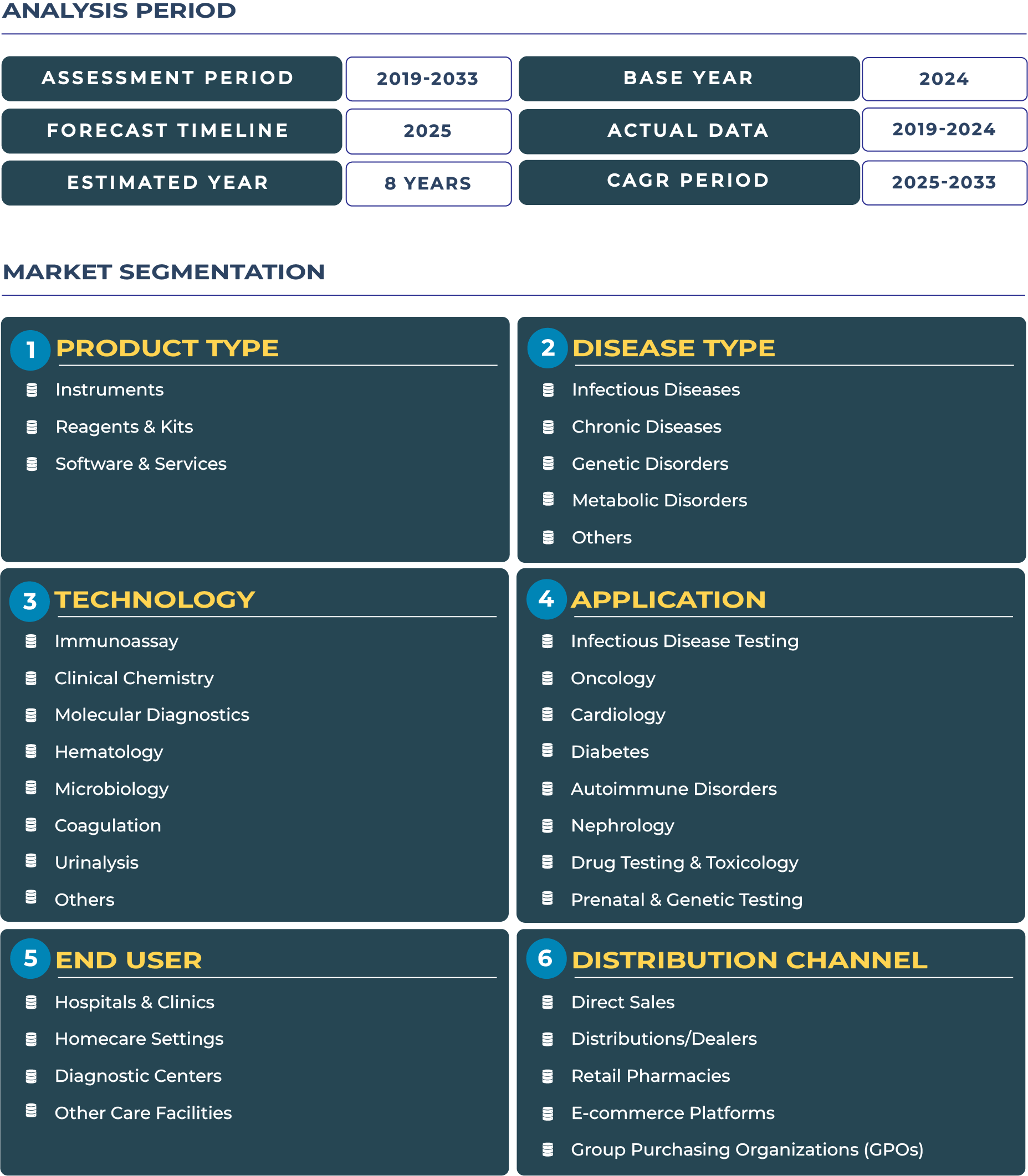Patient-Centric Reforms Reshaping France In-vitro Diagnostic Market: A Transformative Outlook through 2033
France in-vitro diagnostic (IVD) market stands at the crossroads of healthcare modernization and patient-centered policy reform. Over the past decade, the French government has made substantial strides toward making healthcare more equitable, accessible, and innovation-driven. The Ministry of Health and Prevention has introduced wide-ranging reforms under the “Ma Santé 2022” initiative, emphasizing patient safety, diagnostic efficiency, and the adoption of modern medical technologies. These reforms have accelerated the deployment of advanced IVD tools across public and private sectors, laying the foundation for a resilient and responsive diagnostic ecosystem.
In 2025, the France In-vitro Diagnostic Market is valued at USD 3.96 billion, projected to reach USD 5.60 billion by 2033, expanding at a CAGR of 4.4% between 2025 and 2033. This upward trajectory is driven by public hospital modernization programs, precision medicine expansion, and patient-centric reimbursement frameworks that encourage early detection and digital diagnostics. France’s commitment to healthcare equity and innovation underscores its leadership in the European IVD landscape, supported by high regulatory standards and strategic investments in next-generation diagnostic instruments, reagents, and software platforms.
France IVD Market Outlook: Policy-Driven Diagnostic Growth Anchored in Patient-Centric Reform
The trajectory of France IVD market reflects a systemic shift toward preventive and personalized medicine. Healthcare reforms focusing on patient empowerment, transparency in diagnostic processes, and digital integration are strengthening the demand for high-performance reagents and connected diagnostic instruments. France’s national health authority, the Haute Autorité de Santé (HAS), has played a pivotal role in evaluating diagnostic technologies through robust health technology assessments (HTAs), ensuring value-based adoption across the healthcare ecosystem.
Public hospital modernization funds are supporting procurement of automated analyzers, molecular testing systems, and clinical software integration. Meanwhile, private hospitals and ambulatory clinics are increasing their adoption of rapid diagnostic testing systems that support same-day results. The ongoing push for digitized diagnostic records and interoperability among laboratory systems further strengthens the software and services segment. Together, these dynamics illustrate a future-ready IVD ecosystem in France that combines innovation, affordability, and accessibility for its growing patient base.
Drivers & Restraints: Institutional Strength and Structural Barriers Shaping Market Momentum
Public Hospital Investments and Private Sector Expansion Driving Market Momentum
France IVD market benefits from strategic public investments in medical technology infrastructure. Through multi-year funding programs under the “Ségur de la Santé,” billions have been allocated to enhance digital health and diagnostic innovation. The modernization of hospital laboratories and the rise of private ambulatory centers are expanding testing capabilities nationwide. In parallel, strong health technology assessments by HAS ensure that new diagnostic technologies achieve clinical validation and reimbursement alignment, creating an evidence-based pathway for adoption. The growing private ambulatory sector, with its emphasis on efficiency and decentralized testing, is expected to remain a critical growth pillar, particularly in urban areas such as Paris, Lyon, and Marseille.
Reimbursement Challenges and Regional Variability Restricting Adoption Speed
Despite strong government backing, France’s IVD industry contends with strict reimbursement structures and regional variability. The pricing and reimbursement processes overseen by regional health agencies (ARS) are often complex and slow-moving, creating delays for innovative diagnostic technologies entering the public system. Budget constraints in public hospitals, compounded by inflationary pressures and global supply chain volatility, further limit procurement budgets for high-end diagnostic equipment. Additionally, differences in regional policy enforcement across metropolitan and overseas territories lead to unequal adoption rates, impacting smaller IVD providers attempting nationwide scale. The combination of these financial and administrative hurdles emphasizes the need for harmonized funding models that better accommodate diagnostic innovation.
Trends & Opportunities: Ambulatory Transformation and Evidence-Driven Diagnostic Expansion
Ambulatory Migration and Value-Based Diagnostic Adoption Defining Market Evolution
One of the most significant transformations in France IVD landscape is the shift toward ambulatory care and outpatient testing. Hospitals are increasingly outsourcing routine diagnostics to specialized centers, improving efficiency and cost control. The emphasis on “value assessment” by HAS and health insurers is ensuring that diagnostic solutions deliver measurable improvements in patient outcomes. Moreover, the emergence of orthobiologic-inspired regenerative diagnostics and molecular testing in oncology is expanding the boundaries of precision healthcare.
Strategic Opportunities in Private Partnerships and Evidence-Based Innovations
Manufacturers are increasingly targeting ambulatory-ready diagnostic kits and HTA-compliant evidence packages to align with evolving procurement trends. Partnerships between IVD companies and private hospital groups are becoming more frequent, supporting integrated care delivery and rapid test availability. Regional outcomes studies, backed by public health agencies, are helping demonstrate the economic and clinical value of modern IVD technologies. As France continues to expand its telemedicine and digital pathology frameworks, companies offering cloud-integrated laboratory management systems and automated result validation tools are set to gain competitive advantages.
Competitive Landscape: Collaboration, Digital Integration, and Evidence-Based Market Positioning
The French IVD landscape includes a mix of global and domestic players, such as bioMérieux, headquartered in Marcy-l’Étoile. The company continues to lead in clinical microbiology and molecular diagnostics through innovation in rapid testing and pathogen detection platforms. Its strategic collaborations with healthcare providers and the development of AI-assisted laboratory automation have reinforced France’s status as a hub for diagnostic excellence.
Other international players maintain strong footholds in France through R&D centers and distribution partnerships. Many firms are developing HTA-compliant evidence portfolios to ensure smoother reimbursement and tender success, while others are investing in digital connectivity to link laboratory results with hospital information systems. Initiatives like sponsoring regional outcomes studies and launching clinician education programs demonstrate the market’s growing focus on localized, evidence-driven engagement. The combination of strong national regulations, reimbursement oversight, and innovation-oriented competition continues to shape a high-performance, sustainable IVD ecosystem in France.







